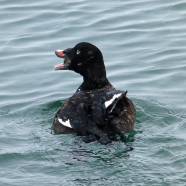Caspian Tern (Hydroprogne caspia) by Scott Kruitbosch
It’s difficult to tell in this photo but Caspian Terns really are enormous birds. At least 9 were feeding in Lake Erie off Dunkirk yesterday in the increasingly blue sky. After another frost last night in Western NY (ugh!) spring temperatures and sunshine will come fast this week.
Read MoreDiving ducks
This past weekend I visited the extremely active Dunkirk Harbor in Dunkirk, New York. It is currently holding thousands of ducks and gulls because just about all of Lake Erie is frozen and this immediate area is kept open by the warm water from the outflow of the adjacent NRG Energy power plant. This particularly frigid year means even more birds than usual are concentrated in this pocket of heat allowing for some great birding and close-up views, especially while birds are feeding and active. I took a few of photos of diving ducks – can you identify any? The first two photos are of...
Read MoreRedhead (Aythya americana) by Twan Leenders
We’ve been posting so many banded birds from Costa Rica and Panama that will head to the U.S. soon and I thought it appropriate to post a banded individual (not by us!) that winters here. This Redhead (Aythya americana) recently allowed Twan to read four of the ten digits on its band, not quite enough to be able to find its origins.
Read MoreLong-tailed Duck (Clangula hyemalis) by Scott Kruitbosch
There’s a reason for the name Long-tailed Duck (Clangula hyemalis), one that does not need any explanation. This was one of two individuals at Dunkirk Harbor (on Lake Erie, NY) today along with thousands of other waterfowl of a couple dozen species. Bald Eagles perched on the ice and flying overhead keep them all very attentive. It’s a spectacle.
Read MoreWaterfowl identification quiz
In this very cold winter season we have been finding a lot of waterfowl concentrated in any areas with open water. As ice takes over nearly every pond, creek, river or lake – even much of the Great Lakes – these birds have to find a hole in these blocks or move to the south. This bird was one of thousands of gulls, ducks, loons, grebes, scoters and more in an unfrozen patch of Lake Erie. Can you identify it? You can barely see the bird’s eye as it rests with bill tucked in. Examine the color patterns on the head, neck, breast, wings and body while looking at the overall...
Read More








